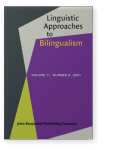Vol. 11:6 (2021) ► pp.753–782
A usage-based approach to productive use of inflectional patterns and level of lemma sophistication in adult heritage speakers’ performance
Convergence on the immigrant variety
Adopting a usage-based perspective, the present study assesses the mental lexicon of Turkish heritage speakers in the UK (HSs, n = 31) regarding the productive use of formulaic inflectional suffix templates and the level of sophistication of the lemmas produced in free speech. We additionally explore input-related predictors of this performance by comparing HS performance to that of a group of previous generation immigrant bilinguals (IBs, n = 61), who are representative input providers, and of a group of monolinguals (n = 44). The results show that overall, both the HSs and IBs diverge from the monolinguals in that they use nominal suffix sequences less productively and rely on less sophisticated nominal lemmas. Their verbal productivity performance, however, remains intact. We argue that altered input results in a performance which diverges from that of the monolinguals but converges on the immigrant variety. The individual variability is partly explained by the amount of L1 passive exposure, indicating that the HSs are not sensitive only to the changes in the input available to them but also to the amount of it. These findings provide new insights into the line of research that describes HSs as incomplete due to their L1-divergent skills in comparison to a monolingual baseline.
Article outline
- 1.Background to the study
- 2.Usage-based approaches and their relevance for the current study
- 3.Inflectional word formation in Turkish and previous studies
- 4.The current study
- 5.Methodology
- 5.1Participants
- 5.2The corpus, transcription and lemmatisation of the data
- 5.3Establishing the suffix formulas and the formulaic productivity measure
- 5.4Level of lemma sophistication
- 5.5Predictors
- 5.5.1Overall suffix template type frequency
- 5.5.2Lemma frequency
- 5.5.3Amount of L1 contact
- 5.5.4Other non-linguistic factors
- 5.6Analysis of the data
- 6.Results
- 7.Discussion
- 8.Conclusion and future directions
- Notes
-
References
